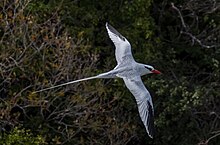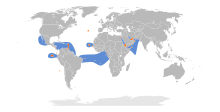
Back Rooibekpylstert Afrikaans رئيس البحر أحمر المنقار Arabic رئيس البحر احمر المنقار ARZ Phaethon aethereus AST Червеноклюн фаетон Bulgarian লালঠোঁটি বিষুবীয়া Bengali/Bangla Phaethon aethereus Breton Cua de jonc bec-roig Catalan Phaethon aethereus CEB Faeton červenozobý Czech
| Red-billed tropicbird | |
|---|---|

| |
| At Little Tobago Island, Trinidad, and Tobago | |
| Scientific classification | |
| Domain: | Eukaryota |
| Kingdom: | Animalia |
| Phylum: | Chordata |
| Class: | Aves |
| Order: | Phaethontiformes |
| Family: | Phaethontidae |
| Genus: | Phaethon |
| Species: | P. aethereus
|
| Binomial name | |
| Phaethon aethereus | |

| |
The red-billed tropicbird (Phaethon aethereus) is a tropicbird, one of three closely related species of seabird of tropical oceans. Superficially resembling a tern in appearance, it has mostly white plumage with some black markings on the wings and back, a black mask and, as its common name suggests, a red bill. Most adults have tail streamers that are about two times their body length, with those in males being generally longer than those in females. The red-billed tropicbird itself has three subspecies recognized, including the nominate. The subspecies mesonauta is distinguished from the nominate by the rosy tinge of its fresh plumage, and the subspecies indicus can be differentiated by its smaller size, more restricted mask, and more orange bill. This species ranges across the tropical Atlantic, eastern Pacific, and Indian Oceans. The nominate is found in the southern Atlantic Ocean, the subspecies indicus in the waters off of the Middle East and in the Indian Ocean, and the subspecies mesonauta in the eastern portions of both the Atlantic and the Pacific Oceans and in the Caribbean. It was one of the many species described by Carl Linnaeus in his 1758 10th edition of Systema Naturae.
Nesting takes place in loose colonies, as they nest a scrape found on a cliff face that is easy to take off from. A single egg is laid and is incubated by both sexes for about six weeks. Whether the egg hatches or not can be influenced by pollution and weather, although the latter has a minimal effect on whether a chick fledges or not. After a chick fledges, the parents will usually stop visiting the nest and the chick will leave. Birds of all ages feed on fish and squid, catching them by diving from the air into the water. However, the red-billed tropicbird sometimes follows surface-feeding predators. The predators will drive the prey to the surface, which are then seized by the tropicbird.
In some areas, introduced black and brown rats raid nests for eggs and young. Cats also threaten the red-billed tropicbird. This bird is considered to be a least-concern species according to the International Union for Conservation of Nature (IUCN), though populations are thought to be declining. In some places, such as Brazil and Mexico, this bird is considered to be threatened.
- ^ BirdLife International (2019). "Phaethon aethereus". IUCN Red List of Threatened Species. 2019: e.T22696637A155736224. doi:10.2305/IUCN.UK.2019-3.RLTS.T22696637A155736224.en. Retrieved 14 February 2022.
